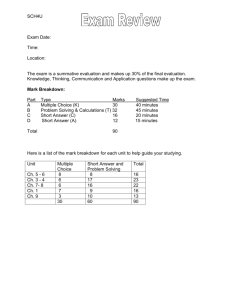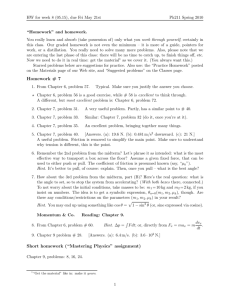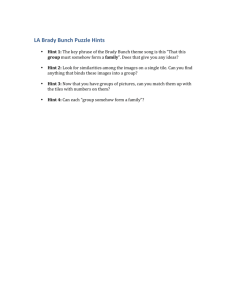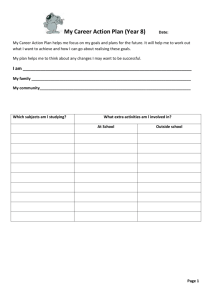MasteringPhysics: Assignmen
advertisement
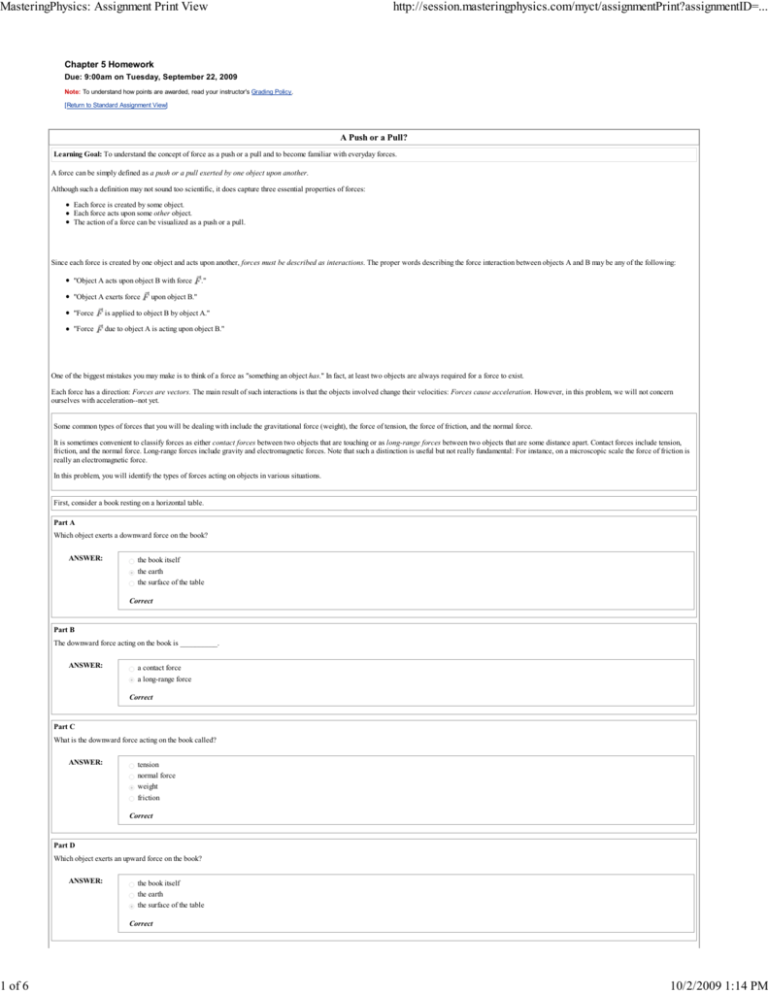
MasteringPhysics: Assignment Print View 1 of 6 http://session.masteringphysics.com/myct/assignmentPrint?assignmentID=... Chapter 5 Homework Due: 9:00am on Tuesday, September 22, 2009 Note: To understand how points are awarded, read your instructor's Grading Policy. [Return to Standard Assignment View] A Push or a Pull? Learning Goal: To understand the concept of force as a push or a pull and to become familiar with everyday forces. A force can be simply defined as a push or a pull exerted by one object upon another. Although such a definition may not sound too scientific, it does capture three essential properties of forces: Each force is created by some object. Each force acts upon some other object. The action of a force can be visualized as a push or a pull. Since each force is created by one object and acts upon another, forces must be described as interactions. The proper words describing the force interaction between objects A and B may be any of the following: "Object A acts upon object B with force "Object A exerts force ." upon object B." "Force is applied to object B by object A." "Force due to object A is acting upon object B." One of the biggest mistakes you may make is to think of a force as "something an object has." In fact, at least two objects are always required for a force to exist. Each force has a direction: Forces are vectors. The main result of such interactions is that the objects involved change their velocities: Forces cause acceleration. However, in this problem, we will not concern ourselves with acceleration--not yet. Some common types of forces that you will be dealing with include the gravitational force (weight), the force of tension, the force of friction, and the normal force. It is sometimes convenient to classify forces as either contact forces between two objects that are touching or as long-range forces between two objects that are some distance apart. Contact forces include tension, friction, and the normal force. Long-range forces include gravity and electromagnetic forces. Note that such a distinction is useful but not really fundamental: For instance, on a microscopic scale the force of friction is really an electromagnetic force. In this problem, you will identify the types of forces acting on objects in various situations. First, consider a book resting on a horizontal table. Part A Which object exerts a downward force on the book? ANSWER: the book itself the earth the surface of the table Correct Part B The downward force acting on the book is __________. ANSWER: a contact force a long-range force Correct Part C What is the downward force acting on the book called? ANSWER: tension normal force weight friction Correct Part D Which object exerts an upward force on the book? ANSWER: the book itself the earth the surface of the table Correct 10/2/2009 1:14 PM MasteringPhysics: Assignment Print View 2 of 6 http://session.masteringphysics.com/myct/assignmentPrint?assignmentID=... Part E The upward force acting on the book is __________. ANSWER: a contact force a long-range force Correct Part F What is the upward force acting on the book called? ANSWER: tension normal force weight friction Correct Now consider a different situation. A string is attached to a heavy block. The string is used to pull the block to the right along a rough horizontal table. Part G Which object exerts a force on the block that is directed toward the right? ANSWER: the block itself the earth the surface of the table the string Correct Part H The force acting on the block and directed to the right is __________. ANSWER: a contact force a long-range force Correct To exert a tension force, the string must be connected to (i.e., touching) the block. Part I What is the force acting on the block and directed to the right called? ANSWER: tension normal force weight friction Correct Part J Which object exerts a force on the block that is directed toward the left? ANSWER: the block itself the earth the surface of the table the string Correct Part K The force acting on the block and directed to the left is __________. ANSWER: a contact force a long-range force Correct Part L What is the force acting on the block and directed to the left called? ANSWER: tension normal force weight 10/2/2009 1:14 PM MasteringPhysics: Assignment Print View 3 of 6 http://session.masteringphysics.com/myct/assignmentPrint?assignmentID=... friction Correct Now consider a slightly different situation. The same block is placed on the same rough table. However, this time, the string is disconnected and the block is given a quick push to the right. The block slides to the right and eventually stops. The following questions refer to the motion of the block after it is pushed but before it stops. Part M How many forces are acting on the block in the horizontal direction? ANSWER: 0 1 2 3 Correct Once the push has commenced, there is no force acting to the right: The block is moving to the right because it was given a velocity in this direction by some force that is no longer applied to the block (probably, the normal force exerted by a student's hand or some spring launcher). Once the contact with the launching object has been lost, the only horizontal force acting on the block is directed to the left--which is why the block eventually stops. Part N What is the force acting on the block that is directed to the left called? ANSWER: tension normal force weight friction Correct The force of friction does not disappear as long as the block is moving. Once the block stops, fricion becomes zero (assuming the table is perfectly horizontal). A World-Class Sprinter World-class sprinters can accelerate out of the starting blocks with an acceleration that is nearly horizontal and has magnitude . Part A How much horizontal force Hint A.1 must a sprinter of mass 46.0 exert on the starting blocks to produce this acceleration? Newton's 2nd law of motion Hint not displayed Express your answer in newtons. ANSWER: = 690 Correct Part B Which body exerts the force that propels the sprinter, the blocks or the sprinter? Hint B.1 How to approach the question Hint not displayed ANSWER: the blocks the sprinter Correct To start moving forward, sprinters push backward on the starting blocks with their feet. As a reaction, the blocks push forward on their feet with a force of the same magnitude. This external force accelerates the sprinter forward. Problem 5.3 A baseball player is sliding into second base. Part A Identify the forces on the baseball player. ANSWER: Normal force Thrust ; Kinetic friction ; Normal force Gravity ; Normal force ; Kinetic friction Gravity ; Normal force ; Static friction 10/2/2009 1:14 PM MasteringPhysics: Assignment Print View 4 of 6 http://session.masteringphysics.com/myct/assignmentPrint?assignmentID=... Correct Problem 5.4 A jet plane is speeding down the runway during takeoff. Air resistance is not negligible, friction is negligible. Part A Identify the forces on the jet. Choose your answers from the following list: A. B. C. D. E. F. G. Gravity Spring Force Tension Normal Force Friction Drag Thrust Enter the letters of all the correct answers in alphabetical order. Do not use commas. For instance, if you think assumptions B and D are required, enter BD. ANSWER: ADFG Correct Understanding Newton's Laws Part A An object cannot remain at rest unless which of the following holds? Hint A.1 How to approach the problem Hint not displayed Hint A.2 Newton's 1st law: a body at rest Hint not displayed ANSWER: The net force acting on it is zero. The net force acting on it is constant and nonzero. There are no forces at all acting on it. There is only one force acting on it. Correct If there is a net force acting on a body, regardless of whether it is a constant force, the body accelerates. If the body is at rest and the net force acting on it is zero, then it will remain at rest. The net force could be zero either because there are no forces acting on the body at all or because several forces are acting on the body but they all cancel out. Part B If a block is moving to the left at a constant velocity, what can one conclude? Hint B.1 How to approach the problem Hint not displayed Hint B.2 Newton's 1st law: a body in motion Hint not displayed ANSWER: There is exactly one force applied to the block. The net force applied to the block is directed to the left. The net force applied to the block is zero. There must be no forces at all applied to the block. Correct If there is a net force acting on a body, regardless of whether the body is already moving, the body accelerates. If a body is moving with constant velocity, then it is not accelerating and the net force acting on it is zero. The net force could be zero either because there are no forces acting on the body at all or because several forces are acting on the body but they all cancel out. Part C A block of mass Hint C.1 is acted upon by two forces: (directed to the left) and (directed to the right). What can you say about the block's motion? How to approach the problem Hint not displayed Hint C.2 Newton's 2nd law Hint not displayed Hint C.3 Relating acceleration to velocity Hint not displayed ANSWER: It must be moving to the left. It must be moving to the right. It must be at rest. 10/2/2009 1:14 PM MasteringPhysics: Assignment Print View 5 of 6 http://session.masteringphysics.com/myct/assignmentPrint?assignmentID=... It could be moving to the left, moving to the right, or be instantaneously at rest. Correct The acceleration of an object tells you nothing about its velocity--the direction and speed at which it is moving. In this case, the net force on (and therefore the acceleration of) the block is to the right, but the block could be moving left, right, or in any other direction. Part D A massive block is being pulled along a horizontal frictionless surface by a constant horizontal force. The block must be __________. Hint D.1 How to approach the problem Hint not displayed Hint D.2 Newton's 2nd law Hint not displayed ANSWER: continuously changing direction moving at constant velocity moving with a constant nonzero acceleration moving with continuously increasing acceleration Correct Since there is a net force acting, the body does not move at a constant velocity, but it accelerates instead. However, the force acting on the body is constant. Hence, according to Newton's 2nd law of motion, the acceleration of the body is also constant. Part E Two forces, of magnitude Hint E.1 and , are applied to an object. The relative direction of the forces is unknown. The net force acting on the object __________. How to approach the problem Hint not displayed Hint E.2 Find the net force when the two forces act on the object in opposite directions Hint not displayed Hint E.3 Find the direction of the net force when the two forces act in opposite directions Hint not displayed Check all that apply. ANSWER: cannot be equal to cannot be equal to cannot be directed the same way as the force of must be greater than Correct Two Forces Acting at a Point Two forces, and , act at a point. has a magnitude of 8.40 and is directed at an angle of 62.0 above the negative x axis in the second quadrant. has a magnitude of 6.00 and is directed at an angle of 52.5 below the negative x axis in the third quadrant. Part A What is the x component of the resultant force? Hint A.1 How to approach the problem Hint not displayed Hint A.2 Find the x component of Hint not displayed Hint A.3 Find the x component of Hint not displayed Express your answer in newtons. ANSWER: -7.60 Correct Part B What is the y component of the resultant force? Hint B.1 How to approach the problem Hint not displayed Hint B.2 Find the y component of 10/2/2009 1:14 PM MasteringPhysics: Assignment Print View 6 of 6 http://session.masteringphysics.com/myct/assignmentPrint?assignmentID=... Hint not displayed Hint B.3 Find the y component of Hint not displayed Express your answer in newtons. ANSWER: 2.66 Correct Part C What is the magnitude of the resultant force? Hint C.1 Magnitude of a vector Hint not displayed Express your answer in newtons. ANSWER: 8.05 Correct Problem 5.6 Two rubber bands pulling on an object cause it to accelerate at . Part A What will be the object's acceleration if it is pulled by four rubber bands? ANSWER: 2.40 Correct Part B What will be the acceleration of two of these objects glued together if they are pulled by two rubber bands? ANSWER: 0.600 Correct Score Summary: Your score on this assignment is 100.6%. You received 40.25 out of a possible total of 40 points. 10/2/2009 1:14 PM

